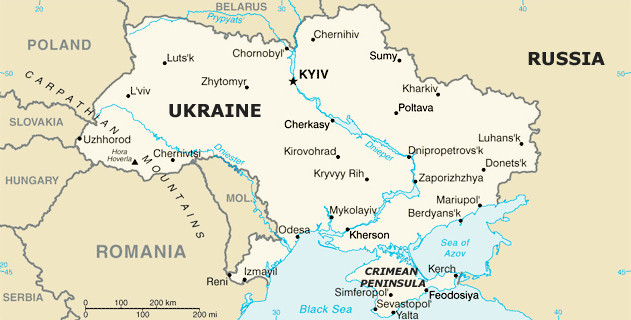JRL NEWSWATCH: “Ukraine’s Civil War: Would Accepting This Terminology Help Resolve the Conflict? [Excerpt]” – PONARS Eurasia

(PONARS Eurasia – Jesse Driscoll – February 2019)
Associate Professor, Political Science; Chair, Global Leadership Institute, University of California San Diego
[Full text: ponarseurasia.org/memo/ukraines-civil-war-would-accepting-terminology-help-resolve-conflict]
(PONARS Policy Memo) Since Ukraine is the site of both an invasion (Crimea) and a civil war (in the Donbas), there is no academic consensus on what to call the crisis in Ukraine. Russians usually call it a civil war. Representatives of the U.S. government emphasize the invasion.
Invasion and civil war are not mutually exclusive terms in academic parlance. Iraq and Afghanistan are recent examples of cases that are well-understood to exemplify both. I propose in this memo that eschewing the term civil war forecloses promising diplomatic avenues for settlement. If the convention of calling Ukraine a civil war was adopted, an “elections first, military drawdown later” sequencing of the Minsk Accords could emerge as a pragmatic resolution path even if Crimea’s final status remains disputed. Several present-day underlying factors-the conventional nature of warfighting, common understandings of harms associated with a permanently frozen conflict in Eastern Europe, and (thankfully) the persistent absence of anti-civilian atrocities by either side-bolster the theory that permanent resolution is not yet out of reach.
A Civil War? Yes
The language of civil war meets the face validity standard for academics, as evidenced by the fact that the Peace Research Institute of Oslo (PRIO) codes the Ukraine conflict as a civil war. If we could put loaded geopolitical implications aside and simply describe conflict processes analytically, the events of 2014 in Ukraine would look familiar to contemporary students of civil war. Consider these facts of the case:
► In the early spring of 2014, the Ukrainian state was incapacitated in the aftermath of anti-regime street protests in the capital. These protests culminated in an irregular regime change that most Ukrainians today refer to as “The Revolution of Dignity.” (The Russian government still calls the Euromaidan events a coup.)
► In the spring of 2014, after the ruling Party of Regions collapsed and the head of state fled, there was a period during which the state security forces could not function according to predictable routines.
► The seizure of Crimea by Russian special forces sent a signal that interstate borders were no longer sacrosanct.
► During the chaotic period that followed, newly-formed pro- and anti-regime militias acted on their own accord (at a minimum, it is clear that not all were taking orders from Moscow or Kyiv). Throughout 2014, the militias fought each other. Throughout most of the country, none of the anti-regime militias had any success seizing state institutions. In the eastern Donbas region of Ukraine, things were different. In this former Party of Regions stronghold, indigenous insurgents captured the regional apparatus of the state in two regions (oblasts) during a window of temporary state incapacitation. Militias clashed, then consolidated, and eventually formed stable coalitions, now referred to as “the Ukrainian army” and “the secessionist rebels” in shorthand.
► Zones of fighting calcified into stable frontlines in the winter of 2015 after Russia sent regular troops to tip the scales at two critical junctures: the battles of Ilovaisk and Debaltseve. Territory has not changed hands significantly since those battles. There is no question that the conflict’s dynamics were-and remain-influenced by outside parties. All of these foreign interveners reliably claim that their motives are humanitarian and defensive while asserting the others’ interventions are nefarious.
► There have been about 10,000 deaths (approximately 6,000 military deaths and 4,000 civilian deaths) resulting from the conflict. The warfighting is conventional. Heavy weaponry deployed against symmetrically armed formations.
► Virtually none of the stakeholders-Russia, Ukraine, the EU, or the United States-have advocated re-drawing the borders of the Ukrainian state in order to disassociate the Donbas territories from Ukraine proper. Moscow has rebuffed numerous secessionist proposals for incorporation of the Donbas into Russia, refusing to replicate the Crimea model. …
Conclusion
The language of civil war is seen as a capitulation to Russia by many people. Because the term emphasizes internal Ukrainian politics, it can be confused with blaming the victim or whitewashing Russia’s role in fomenting the conflict. That is not my advocacy. The taboo of employing the phrase civil war when describing the conflict, however, may be a barrier to conflict resolution of the crisis. If both Western academics and policymakers adopted the convention of calling Ukraine a civil war, we would be better positioned to read the letter of the Minsk Accords as a pragmatic script for resolving the conflict cooperatively. We may be better equipped to recognize the valid concerns of the Russian-speaking Ukrainian population and identify specific issues that require resolution or should be prioritized in rebuilding. A peaceful settlement to the conflict is best pursued by supporting free and fair elections in the Donbas regions alongside the regular elections scheduled for the coming calendar year.
Full article appeared at ponarseurasia.org/memo/ukraines-civil-war-would-accepting-terminology-help-resolve-conflict bearing the following notice:
PONARS Eurasia © 2018 All rights reserved
with the text “Permissions & Citation Guidelines” linking to ponarseurasia.org/permissions-citation-guidelines, which, in turns, bears the notice:
Permission:
Content by PONARS Eurasia may be re-distributed for Fair Use (non-commercial) purposes with credit provided to PONARS Eurasia and the author(s) and with a hyperlink/URL pointing to the original content page on this website.
